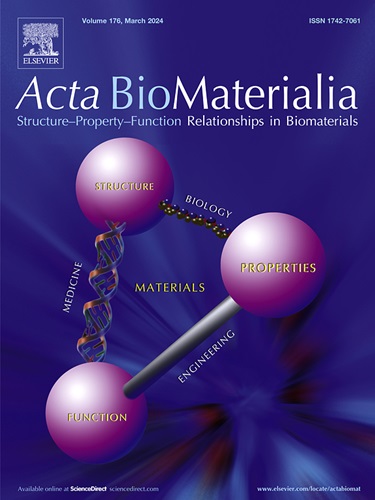Arsenene-Vanadene nanodots co-activate Apoptosis/Ferroptosis for enhanced chemo-immunotherapy
IF 9.4
1区 医学
Q1 ENGINEERING, BIOMEDICAL
引用次数: 0
Abstract
Triple-Negative Breast Cancer (TNBC) represents a highly aggressive subtype of breast cancer with an unfavorable prognosis, characterized by minimal immune infiltration and pronounced immune suppression, resulting in a limited response to immunotherapy. In this study, a multifunctional Arsenene-Vanadene nanodot (AsV) drug delivery system is introduced, which responds to the tumor microenvironment by releasing arsenic and vanadium. Arsenic undergoes oxidation to generate highly toxic trivalent arsenic, which induces apoptosis in tumor cells while utilizing apoptotic cell debris to transiently activate the immune system. Additionally, arsenic binds to cysteine, indirectly facilitating ferroptosis. Concurrently, vanadium's redox cycling properties are harnessed to trigger a Fenton-like reaction, promoting lipid peroxidation. Furthermore, ferroptosis is enhanced through the depletion of glutathione and inactivation of glutathione peroxidase 4 (GPX4), leading to the release of damage-associated molecular patterns and thereby amplifying the anti-tumor immune response. This study represents the first instance of integrating arsenene's apoptosis-inducing properties with vanadium's ferroptosis-enhancing effects, providing a synergistic approach to improving the immunotherapeutic response and offering a potential strategy for enhancing TNBC prognosis.
Statement of Significance
Triple-negative breast cancer (TNBC) exhibits resistance to immunotherapy due to its highly immunosuppressive tumor microenvironment. In this study, tumour-responsive Arsenene-Vanadene nanodots (AsV) were developed to induce a synergistic effect by triggering apoptosis and ferroptosis through microenvironment-specific mechanisms. The arsenic component generates cytotoxic trivalent arsenic, promoting apoptosis while binding to cysteine, thereby reducing GSH synthesis. Simultaneously, vanadium initiates lipid peroxidation through Fenton-like reactions and disruption of the glutathione/GPX4 axis, further amplifying ferroptotic cell death. This dual-action system transforms tumor cell debris into immune-stimulating signals while circumventing conventional immunotherapy limitations. As the first strategy integrating arsenic-induced apoptosis with vanadium-enhanced ferroptosis, this approach provides a mechanistic framework to overcome TNBC immunosuppression through coordinated cell death pathways, demonstrating potential for precision nanomedicine applications.

砷-钒纳米点共同激活细胞凋亡/铁凋亡增强化学免疫治疗。
三阴性乳腺癌(TNBC)是一种预后不良的高侵袭性乳腺癌亚型,其特点是免疫浸润最小,免疫抑制明显,导致对免疫治疗的反应有限。本研究介绍了一种多功能砷钒纳米点(AsV)给药系统,该系统通过释放砷和钒来响应肿瘤微环境。砷经过氧化生成高毒性的三价砷,诱导肿瘤细胞凋亡,同时利用凋亡的细胞碎片短暂激活免疫系统。此外,砷与半胱氨酸结合,间接促进铁下垂。同时,钒的氧化还原循环特性被利用来触发芬顿样反应,促进脂质过氧化。此外,通过谷胱甘肽的耗竭和谷胱甘肽过氧化物酶4 (GPX4)的失活,导致损伤相关分子模式的释放,从而增强抗肿瘤免疫反应,铁凋亡得以增强。本研究首次将砷的细胞凋亡诱导特性与钒的细胞凋亡增强效应结合起来,为改善TNBC的免疫治疗反应提供了协同途径,并为改善TNBC的预后提供了潜在的策略。意义声明:三阴性乳腺癌(TNBC)由于其高度免疫抑制的肿瘤微环境而表现出对免疫治疗的耐药性。在这项研究中,研究人员开发了肿瘤反应性的砷-钒纳米点(AsV),通过微环境特异性机制触发细胞凋亡和铁下垂,从而诱导协同效应。砷成分产生细胞毒性三价砷,与半胱氨酸结合促进细胞凋亡,从而减少谷胱甘肽的合成。同时,钒通过芬顿样反应和破坏谷胱甘肽/GPX4轴引发脂质过氧化,进一步放大铁致细胞死亡。这种双作用系统将肿瘤细胞碎片转化为免疫刺激信号,同时绕过传统免疫治疗的局限性。作为首个将砷诱导的细胞凋亡与钒增强的铁凋亡结合起来的策略,该方法提供了一个机制框架,通过协调细胞死亡途径克服TNBC免疫抑制,显示了精密纳米医学应用的潜力。
本文章由计算机程序翻译,如有差异,请以英文原文为准。
求助全文
约1分钟内获得全文
求助全文
来源期刊

Acta Biomaterialia
工程技术-材料科学:生物材料
CiteScore
16.80
自引率
3.10%
发文量
776
审稿时长
30 days
期刊介绍:
Acta Biomaterialia is a monthly peer-reviewed scientific journal published by Elsevier. The journal was established in January 2005. The editor-in-chief is W.R. Wagner (University of Pittsburgh). The journal covers research in biomaterials science, including the interrelationship of biomaterial structure and function from macroscale to nanoscale. Topical coverage includes biomedical and biocompatible materials.
 求助内容:
求助内容: 应助结果提醒方式:
应助结果提醒方式:


